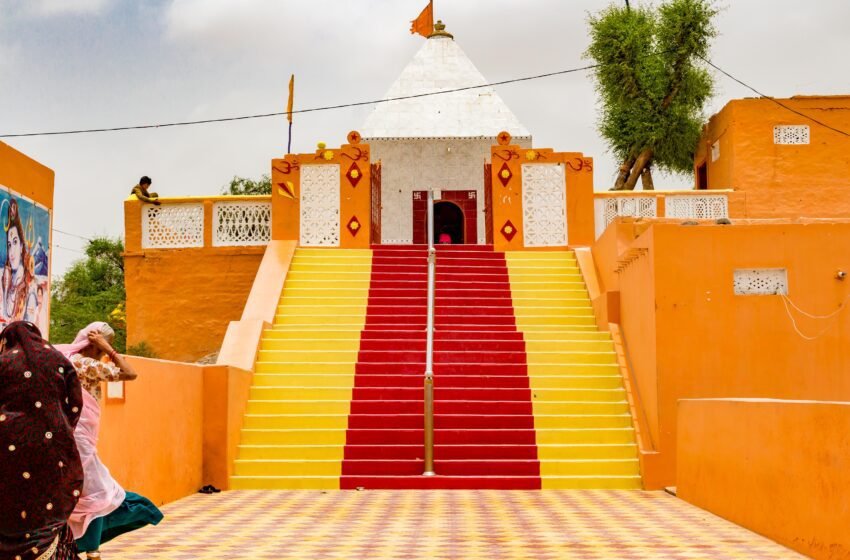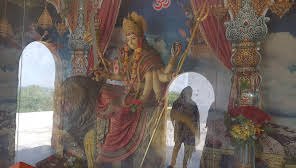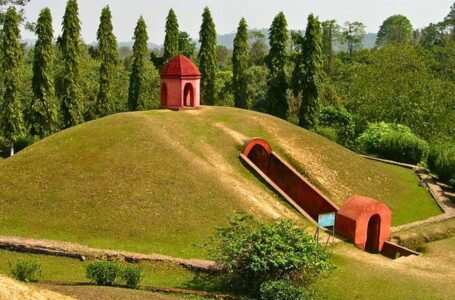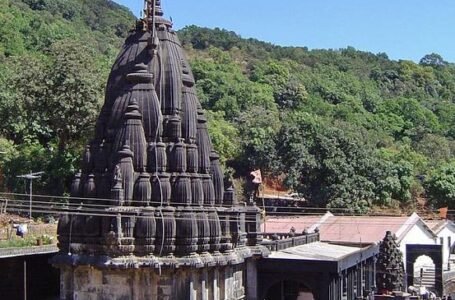Umerkot Shiv Mandir: A Sacred Gem in Sindh
- Ancient history Asian history Indian Mythology
 Prashant Kumar
Prashant Kumar- May 14, 2024
- 0
- 122

The Umarkot Shiv Mandir, also known as Amarkot Shiv Mandir, stands as an ancient Hindu temple in the Umerkot District of Sindh. Thousands of years ago, a humble cowherd noticed something peculiar. One of his cows consistently left the herd to offer milk to a mysterious object—a Shiv Lingam. Intrigued, the man investigated and discovered the divine presence of Lord Shiva. Thus, the Shiv Mandir was born, becoming a beacon of faith for generations. Shiv Lingam, revered as one of the finest in the world. Legend whispers that the Lingam continued to grow, defying earthly constraints. Locals marked its height, witnessing its divine expansion—a silent testimony to cosmic forces at play.

A neatly tiled staircase, painted in yellow and red, leads to the middle-sized courtyard. The entrance sets the tone for the temple’s spiritual significance and The current structure of the temple was expanded by a Muslim man about a century ago. Inside the main temple, the air is filled with the musky and rich fragrance of amber. The central focus is the Shiva Lingam, which is considered one of the best in the world.. Legend has it that the Lingam continued to grow until locals marked its height, witnessing its divine expansion. Despite its ancient roots, the temple’s structure reflects harmonious coexistence. The stones whisper tales of devotion, while the Lingam remains the focal point. Every year during Maha Shivaratri, the temple hosts a grand three-day festival. Pilgrims from both lower and upper Sindh converge here, immersing themselves in prayers, rituals, and celebration. The temple’s architecture bridges the past and present, inviting seekers to witness eternity in stone. It stands as a living testament to shared cultural heritage and the enduring spirit of unity.

This dedicated group plays a pivotal role in managing the temple, They oversee regular repairs, ensuring that the temple remains structurally sound, Their commitment extends beyond maintenance; they’ve built essential amenities like a guesthouse and a community hall to accommodate visitors. The local community reveres the temple as a sacred place. During festivals, such as Maha Shivaratri, they actively participate, contributing to the vibrant celebrations. Their collective devotion infuses life into the ancient stones and rituals. The temple stands as a testament to Sindh’s rich Hindu heritage, Locals recognize its historical significance and take pride in safeguarding it for future generations, Their unwavering commitment ensures that the temple remains a beacon of faith and cultural continuity.
Over time, the temple suffered from neglect due to changing socio-political dynamics and lack of consistent maintenance, Crumbling walls, weathered structures, and broken bricks were common sights, The temple stands amidst a bustling city, surrounded by crowded streets Illegal transport terminals and auto-rickshaws near the outer walls encroached upon its space, The fortification wall, standing at 45 feet witnessed executions during the British colonial era. Balancing historical preservation with contemporary requirements (such as transportation) posed challenges. The local community, while committed, faced resource constraints. Repairing and maintaining ancient structures demands financial and human resources, Raising awareness about the temple’s significance and garnering community support were ongoing struggles, Occasions like the Shiva festival served as reminders but needed sustained efforts.

The Umerkot Qila, as it is locally known, stands as a transitional point of the Mughal Dynasty, It played a crucial role during the reign of Akbar, the third emperor of the Mughal Dynasty, Akbar was born in Umerkot when his father, Emperor Humayun, sought refuge here after defeat by Afghan King Sher Shah Suri. Over time, the fort suffered from neglect due to the ravages of time and changing circumstances. Crumbling walls and years of abandonment threatened its existence.
In 2016, heritage authorities began restoring the fort. A wide staircase made of burnt red bricks now leads to a high platform overlooking the city. The platform features seven discarded brass cannons arranged in a circle, with the Pakistani flag fluttering at its centre. The site, once used for executions by the colonial British army, has been preserved. The fort houses a museum that remains a central attraction for visitors. Inside, ancient manuscripts, coins, paintings, calligraphy specimens, royal documents, jewellery, Mughal-era arms, and Jain and Hindu sculptures provide glimpses into different historical periods. Despite resource constraints, efforts have been made to maintain and showcase these artefacts. Thanks to restoration work, the Umerkot Qila is now in a relatively presentable state, Its historical and architectural significance continues to resonate with visitors and locals alike.

Modernization has left its mark on the Umerkot Shiv Mandir, influencing both the temple itself and its sacred rituals. Let’s explore how:
Despite the passage of time and changing social dynamics, the temple continues to host traditional rituals, The Shiva festival, held annually, draws thousands of Hindu devotees who throng to the temple to pay homage to Lord Shiva. As pilgrims pass through Muslim villages en route to the temple, they are served drinks—a testament to interfaith harmony in Sindh, The temple’s walls adorned with Om symbols welcome yatris, bridging ancient traditions with modern sensibilities. The temple is managed by the All Hindu Panchayat of Umarkot. They have undertaken regular repairs, ensuring the temple’s structural integrity. To accommodate the growing number of pilgrims, they’ve built a guesthouse, community hall, and other amenities.
In recent years, Hindus in Sindh have constructed grand temples across towns and cities. Mithi boasts opulent temples dedicated to Hanuman and Krishna. Other temples, such as Parbharm and Sant Nenuram, regularly host religious celebrations. While Sindh is renowned for its Hindu heritage, it also has a Sikh history, New gurdwaras have been erected in Umerkot and Mithi, and the Guru Nanak Gurdwara was renovated recently.

Tourism has significantly impacted the Umerkot Shiv Mandir, also known as Amarkot Shiv Mandir, and its surroundings. Let’s explore how:
Pilgrims pass through Muslim villages en route to the temple. Despite religious differences, interfaith harmony prevails, and the pilgrims are served drinks along the way, The temple gates adorned with Om symbols symbolise the coexistence of ancient traditions and modern sensibilities. The temple is managed by the All Hindu Panchayat of Umarkot, They’ve undertaken regular repairs and built essential amenities. A guesthouse, community hall, and other facilities accommodate the growing number of pilgrims each year. Hindus in Sindh have been constructing grand temples across towns and cities, Mithi, for instance, boasts opulent temples dedicated to Hanuman and Krishna, Religious celebrations are also held at temples like Parbharm and Sant Nenuram. Sindh not only has Hindu heritage but also a Sikh history, New gurdwaras have been erected in Umerkot and Mithi, preserving Sikh heritage.

The Umarkot Shiv Mandir stands as more than just an architectural marvel, it embodies the enduring spirit of faith, unity, and cultural continuity. Its ancient stones echo with centuries of reverence, while the magnificent Shiv Lingam symbolises the eternal presence of Lord Shiva. As pilgrims gather each year during Maha Shivaratri, they honour tradition, celebrate diversity, and reaffirm their unwavering connection to the divine. The temple’s walls, adorned with Om symbols, bridge ancient wisdom with modern sensibilities, reminding us that sacred spaces transcend time and boundaries


